Hotpoint ENTM 18010 V, ENTM 18050 V, ENTM 18020 V Manual

ENTM 18010 (EX)
ENTM 18110 V (EX)
ENTM 18020 (EX)
English
Operating Instructions
2-DOOR FRIDGE
Contents
Operating Instructions, 1
Assistance,2
Description of the appliance, 4
Reversible doors, 6
Installation, 7
Start-up and use, 7
Maintenance and care, 8
Precautions and tips, 9
Troubleshooting, 10
Français
Mode d’emploi
REFRIGERATEUR 2 PORTES
Sommaire
Mode d’emploi, 1
Assistance, 2
Description de l’appareil, 4
Réversibilité des portes, 6
Installation, 11
Mise en marche et utilisation, 11
Entretien et soin, 12
Précautions et conseils, 13
Anomalies et remèdes, 14
Español
Manual de instrucciones
FRIGORÍFICO DE 2 PUERTAS
Sumario
Manual de instrucciones, 1
Asistencia,2
Descripción del aparato, 5
Reversibilidad de la apertura de las puertas, 6
Instalación, 15
Puesta en funcionamiento y uso, 15
Mantenimiento y cuidados, 16
Precauciones y consejos, 17
Anomalías y soluciones, 18
Portuges
Instruções para a utilização
FRIGORÍFICO 2 PORTAS
Índice
Instruções para a utilização, 1
Assistência,3
Descrição do aparelho, 5
Reversibilidade da abertura das portas, 6
Instalação, 19
Início e utilização, 19
Manutenção e cuidados, 20
Precauções e conselhos, 21
Anomalias e soluções, 22
AR
ليغشتلا تاميلعت
ديمجت ةرجح سرهفلا
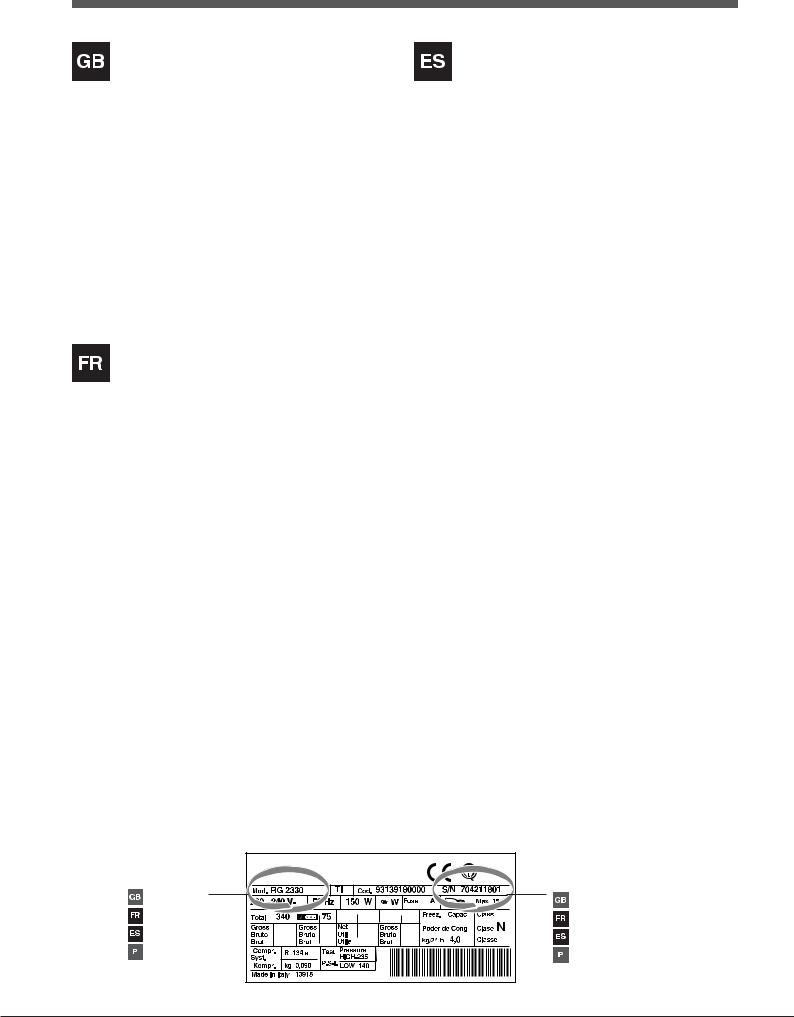
Assistance
Before calling for Assistance:
•Check if the malfunction can be solved on your own (see Troubleshooting).
•If after all the checks, the appliance still does not operate or the problem persists, call the nearest Service Centre
Communicating:
•type of malfunction
•appliance model (Mod.)
•serial number (S/N)
This information can be found on the data plate located on the bottom left side of the refrigerator compartment.
Never call on unauthorized technicians and always refuse spare parts which are not originals.
Asistencia
Antes de llamar al Servicio de Asistencia Técnica:
•Verifique si la anomalía puede ser resuelta por Ud. mismo (ver Anomalías y Soluciones).
•Si, no obstante todos los controles, el aparato no funciona y el inconveniente por Ud detectado continúa, llame al Centro de Asistencia Técnico más cercano.
Comunique:
•el tipo de anomalía
•el modelo de la máquina (Mod.)
•el número de serie (S/N)
Esta información se encuentra en la placa de características ubicada en el compartimento frigorífico abajo a la izquierda.
No recurra nunca a técnicos no autorizados y rechace siempre la instalación de repuestos que no sean originales.
La siguiente información es válida solo para España.
Para otros países de habla hispana consulte a su vendedor.
Assistance
Avant de contacter le centre d’Assistance :
•Vérifiez si vous pouvez résoudre l’anomalie vous-même (voir Anomalies et Remèdes).
•Si, malgré tous ces contrôles, l’appareil ne fonctionne toujours pas et si l’inconvénient persiste, appelez le service après-vente le plus proche.
Signalez-lui :
•le type d’anomalie
•le modèle de l’appareil (Mod.)
•le numéro de série (S/N)
Vous trouverez tous ces renseignements sur l’étiquette signalétique placée dans le compartiment réfrigérateur en bas à gauche.
Ne vous adressez jamais à des techniciens non agréés et exigez toujours l’installation de pièces détachées originales.
Ampliación de garantía
Llame al 902.363.539 y le informaremos sobre el fantástico plan de ampliación de garantía hasta 5 años.
Consiga una cobertura total adicional de
•Piezas y componentes
•Mano de obra de los técnicos
•Desplazamiento a su domicilio de los técnicos
Y NO PAGUE AVERIAS NUNCA MAS
Servicio de asistencia técnica (SAT)
Llame al 902.133.133 y nuestros técnicos intervendrán con rapidez y eficacia, devolviendo el electrodoméstico a sus condiciones óptimas de funcionamiento.
En el SAT encontrará recambios, accesorios y productos específicos para la limpieza y mantenimiento de su electrodoméstico a precios competitivos.
ESTAMOS A SU SERVICIO
- model |
- serial number |
- modèle |
- numéro de série |
- modelo |
- número de serie |
- modelo |
- número de série |
2

Assistência
Antes de contactar a Assistência técnica:
•Verifique se pode resolver sozinho a anomalia (veja as Anomalias e Soluções).
•Se, apesar de todos os controlos, o aparelho não funcionar e o inconveniente detectado continuar, contactar o Centro de Assistência mais próximo.
Comunique:
•o tipo de anomalia
•o modelo da máquina (Mod.)
•o número de série (S/N)
Estas informações encontram-se na placa de identificação situada no compartimento frigorífico embaixo à esquerda.
Nunca recorrer a técnicos não autorizados e negar sempre a instalação de peças sobresselentes não originais para reposição.
 - model
- model  - modèle
- modèle
 - modelo
- modelo  - modelo
- modelo
 - serial number
- serial number
 - numéro de série
- numéro de série
 - número de serie
- número de serie  - número de série
- número de série
3
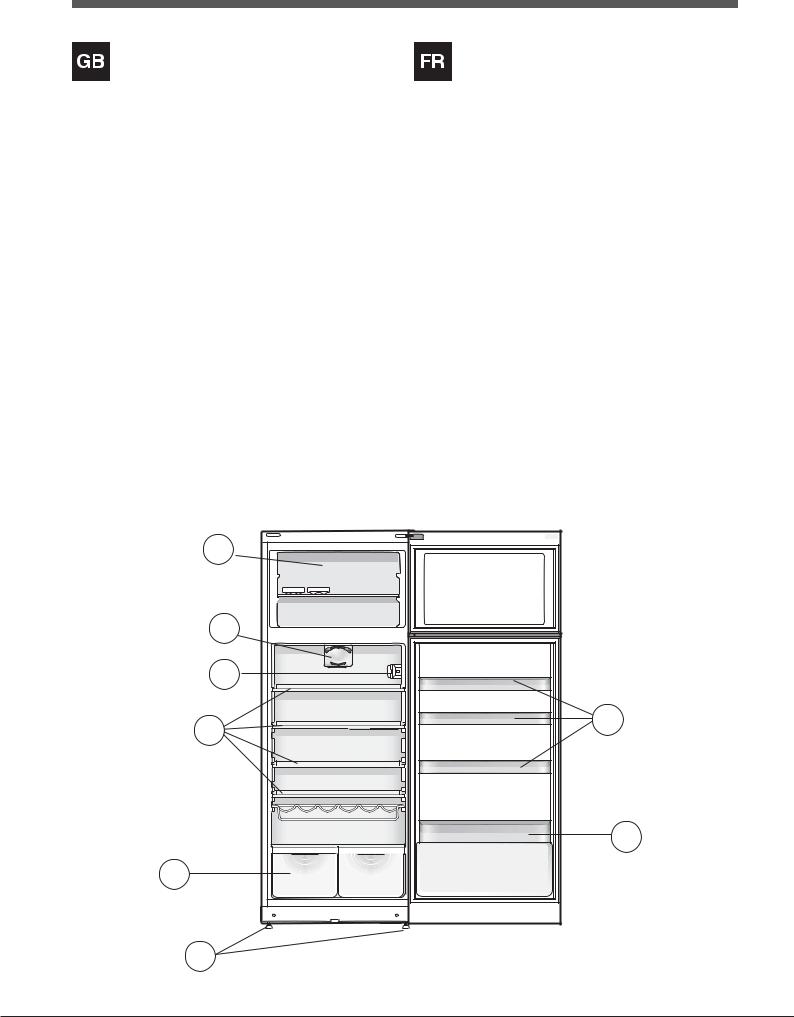
Description of the appliance
Overall view
The instructions contained in this manual are applicable to different model refrigerators. The diagrams may not directly represent the appliance purchased. For more complex features, consult the following pages.
1Levelling FEET
2FRUIT and VEGETABLE bin
3SHELVES*
4TEMPERATURE REGULATING Knob
5AIR*
6FREEZER and STORAGE compartment
7Removable multipurpose SHELVES*
8BOTTLE shelf
*Varies by number and/or position, available only on certain models.
Description de l’appareil
Vue d’ensemble
Ces instructions d’utilisation s’appliquent à plusieurs modèles, il se peut donc que les composants illustrés présentent des différences par rapport à ceux de l’appareil que vous avez acheté. Vous trouverez dans les pages suivantes la description des objets plus complexes.
1PIED de réglage
2Bac FRUITS et LEGUMES
3CLAYETTE*
4Commande pour RÉGLER LA TEMPÉRATURE
5AIR*
6Compartiment CONGELATION et CONSERVATION
7Balconnet amovible PORTE-OBJETS*
8Balconnet BOUTEILLES
*Leur nombre et/ou leur emplacement peut varier, n’existe que sur certains modèles.
6 |
|
5 |
|
4 |
|
3 |
7 |
|
|
|
8 |
2 |
|
1 |
|
4
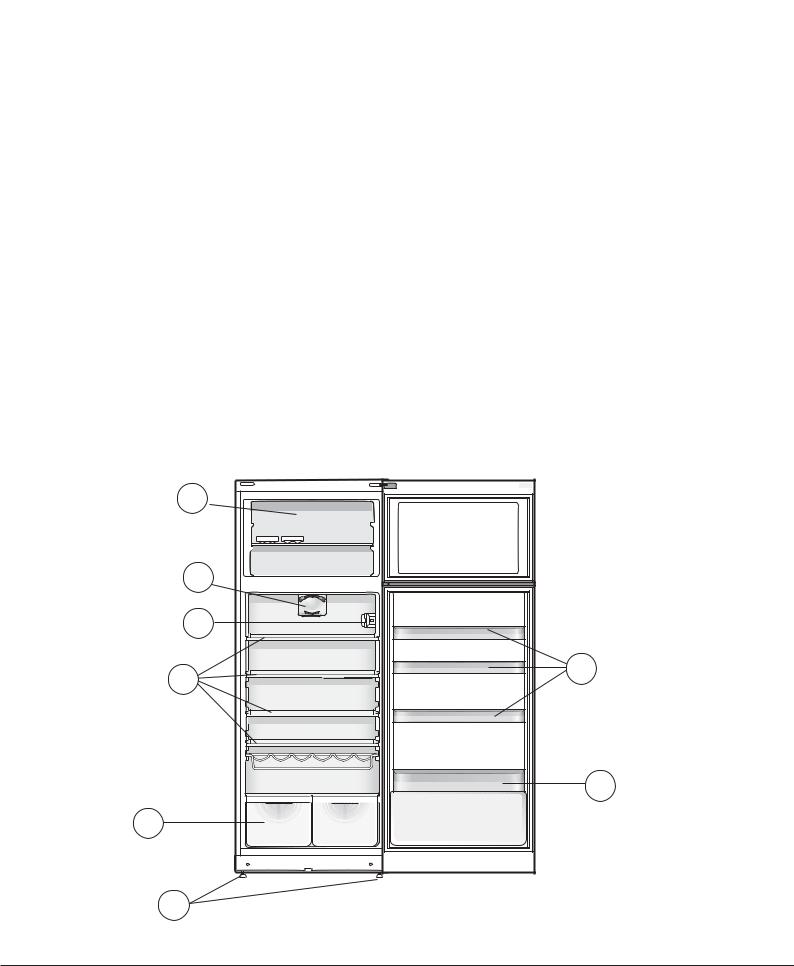
|
|
|
|
|
|
|
|
|
|
|
|
Descripción del aparato |
Descrição do aparelho |
||
Vista en conjunto
Las instrucciones sobre el uso son válidas para distintos modelos y por lo tanto es posible que la figura presente detalles diferentes a los del aparato que Ud. ha adquirido. La descripción de las piezas más complejas se encuentra en las páginas sucesivas.
1PATAS de regulación
2Recipiente FRUTA y VERDURA
3BANDEJAS*
4Mando para la REGULACIÓN DE LA TEMPERATURA
5AIR*
6Compartimiento CONGELAMIENTO y CONSERVACIÓN
7Balconcito extraíble PORTAOBJETOS*
8Balconcito BOTELLAS
*La cantidad y/o su ubicación pueden variar, se encuentra solo en algunos modelos.
Visão geral
Estas instruções sobre a utilização são válidas para vários modelos, portanto é possível que na figura haja pormenores diferentes do aparelho que adquiriu. Há uma descrição dos assuntos mais complexos nas páginas seguintes.
1PEZINHO de regulação
2Gaveta para FRUTAS e HORTALIÇAS
3PRATELEIRA*
4Manípulo para a REGULAÇÃO DA TEMPERATURA
5AIR*
6Compartimento para CONGELAÇÃO e CONSERVAÇÃO
7Prateleira extraível da porta VÃO PARA GUARDAR OBJECTOS*
8Prateleira para GARRAFAS
*Variáveis em número e/ou na posição, presente somente em alguns modelos.
6 |
|
5 |
|
4 |
|
3 |
7 |
|
|
|
8 |
2 |
|
1 |
|
5

Reversible doors
If it is necessary to change the direction in which the doors open, please contact the Technical Assistance Centre.
Réversibilité des portes
Si une inversion du sense d’ouverture des portes s’avère nécessaire, faire appel à notre service d’assistance technique.
.
Reversibilidad de la apertura de las puertas
Cuando sea necesario cambiar el sentido de apertura de las puertas, llame al servicio de Asistencia Técnica.
Reversibilidade da abertura das portas
No caso em que se torne necessário inverter o sentido de abertura das portas, contacte o serviço de Assistência Técnica.
6
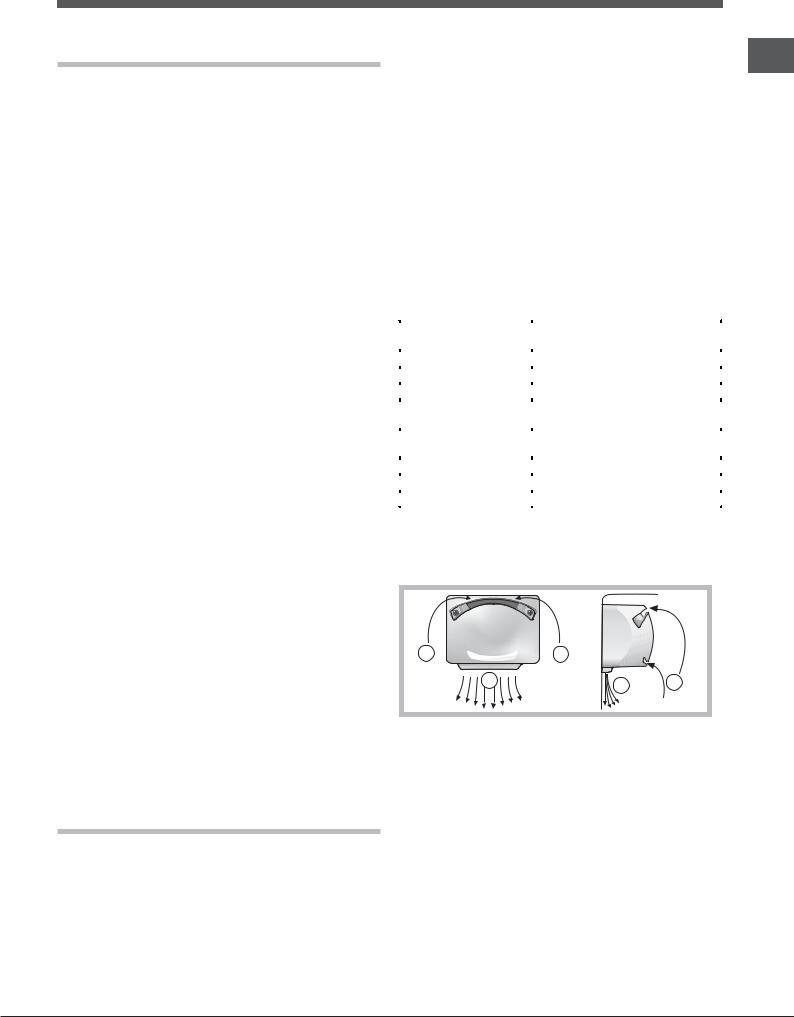
Installation
!Before placing your new appliance into operation please read these operating instructions carefully. They contain important information for safe use, for installation and for care of the appliance.
!Please keep these operating instructions for future reference. Pass them on to possible new owners of the appliance.
Positioning and connection
Positioning
1.Place the appliance in a well-ventilated humidity-free room.
2.Do not obstruct the rear fan grills. The compressor and condenser give off heat and require good ventilation to operate correctly and save energy.
3.Leave a space of at least 10 cm between the top part of the appliance and any furniture above it, and at least 5 cm between the sides and any furniture/side walls.
4.Ensure the appliance is away from any sources of heat (direct sunlight, electric stove, etc.).
5.In order to maintain the correct distance between the appliance and the wall behind it, fit the spacers supplied in the installation kit, following the instructions provided.
Levelling
1.Install the appliance on a level and rigid floor.
2.If the floor is not perfectly horizontal, adjust the refrigerator by tightening or loosening the front feet.
Electrical connections
After the appliance has been transported, carefully place it vertically and wait at least 3 hours before connecting it to the electricity mains. Before inserting the plug into the electrical socket ensure the following:
•The appliance is earthed and the plug is compliant with the law.
•The socket can withstand the maximum power of the appliance, which is indicated on the data plate located on the bottom left side of the fridge (e.g. 150 W).
•The voltage must be in the range between the values indicated on the data plate located on the bottom left side (e.g. 220-240V).
•The socket is compatible with the plug of the appliance. If the socket is incompatible with the plug, ask an authorised technician to replace it (see Assistance). Do not use extension cords or multiple sockets.
!Once the appliance has been installed, the power supply cable and the electrical socket must be easily accessible.
!The cable must not be bent or compressed.
!The cable must be checked regularly and replaced by authorised technicians only (see Assistance).
!The manufacturer declines any liability should these safety measures not be observed.
Start-up and use
Starting the appliance
! Before starting the appliance, follow the installation
instructions (see Installation).
! Before connecting the appliance, clean the compartments and accessories well with lukewarm water and bicarbonate.
1.Insert the plug into the socket and ensure that the internal light illuminates.
2.Turn the TEMPERATURE ADJUSTMENT knob to an average value. After a few hours you will be able to put food in the refrigerator.
Setting the temperature
The temperature inside the refrigerator compartment automatically |
GB |
||
adjusts itself according to the position of the TEMPERATURE |
|
||
ADJUSTMENT knob. |
|
|
|
1 = warmest |
5 = coldest |
|
|
We recommend, however, a medium position. |
|
||
The cooling section of the refrigerator is located inside the back wall |
|
||
of the refrigerator compartment for increased space and improved |
|
||
aesthetics. During operation, the back wall will be covered in frost |
|
||
or water droplets depending on whether the compressor is |
|
||
operating or paused. Do not worry, the refrigerator is functioning |
|
||
normally. |
|
|
|
If the TEMPERATURE ADJUSTMENT knob has been set on high |
|
||
values with large quantities of food and with a high ambient |
|
||
temperature, the appliance can operate continuously, resulting in |
|
||
excessive frost formation and excessive energy consumption: |
|
||
compensate for this by shifting the knob towards lower values |
|
||
(defrosting will occur automatically). In static appliances, the air |
|
||
circulates in a natural way: the colder air tends to move downwards |
|
||
as it is heavier. The food should be stored as follows: |
|
||
|
|
|
|
Food |
Arrangement inside the |
|
|
refrigerator |
|
|
|
|
|
|
|
Fresh fish and meat |
Above the fruit and vegetable bins |
|
|
Fresh cheese |
Above the fruit and vegetable bins |
|
|
Cooked food |
On any shelf |
|
|
Salami, loaves of bread, |
On any shelf |
|
|
chocolate |
|
|
|
Fruit and vegetables |
In the fruit and vegetable |
|
|
compartment bins |
|
|
|
|
|
|
|
Eggs |
On the shelf provided |
|
|
Butter and margarine |
On the shelf provided |
|
|
Bottles, drinks, milk |
On the shelves provided |
|
|
AIR *
It is recognizable due to the presence of the mechanism on the top part of the refrigerator compartment (see diagram).
B
 B
B
A |
A |
B |
AIR maximises air circulation, improving the efficiency of the evaporator and helping to achieve the optimal temperature inside the refrigerator as quickly as possible each time it has been opened. The blown air (A) is cooled when it comes into contact with the cold wall, whereas the hotter air (B) is sucked up (see diagram).
The AIR products are also equipped with a filter which, thanks to the inclusion of silver ions, makes it possible to reduce bacteria by 70% and to eliminate odours inside the refrigerator unit, thereby guaranteeing improved food storage.
If the TEMPERATURE ADJUSTMENT knob has been set on high values with large quantities of food and with a high ambient temperature, the appliance can operate continuously, resulting in excessive frost formation and excessive energy consumption: compensate for this by shifting the knob towards lower values (defrosting will occur automatically).
*Varies by number and/or position, available only on certain models.
7
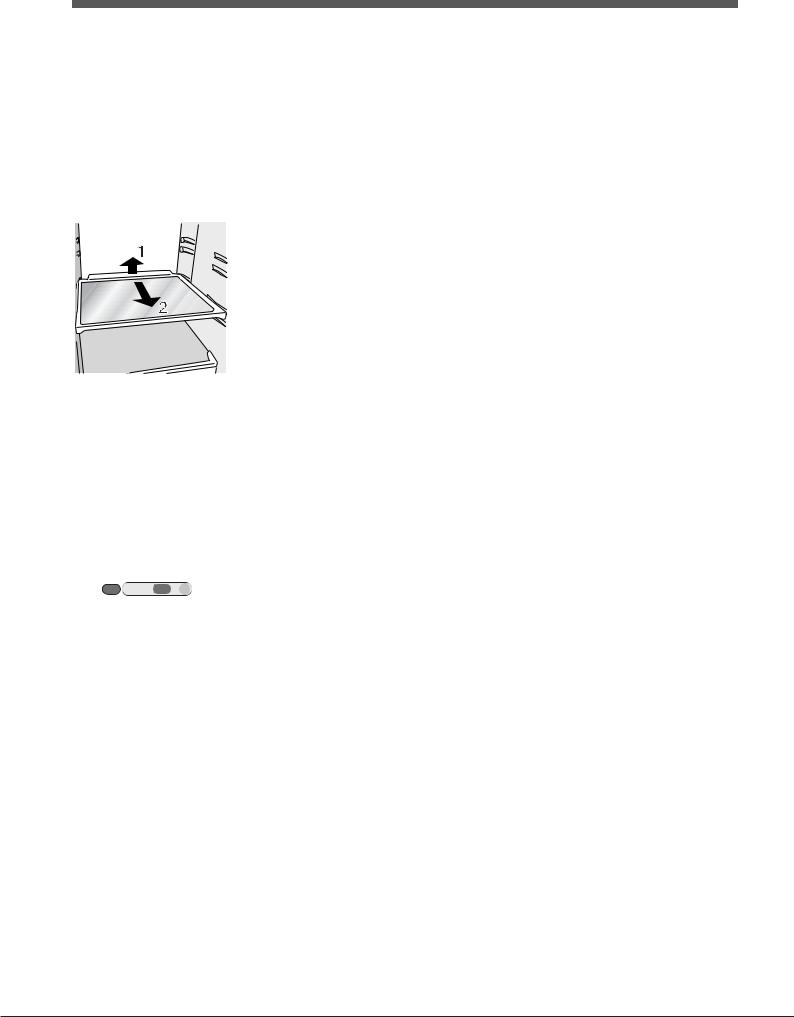
|
Using the refrigerator to its full potential |
|||
GB |
||||
• Place only cold or lukewarm foods in the compartment, not hot |
||||
|
|
foods (see Precautions and tips). |
||
|
||||
|
• Remember that cooked foods do not last longer than raw foods. |
|||
|
• Do not store liquids in open containers. They will increase |
|||
|
|
humidity in the refrigerator and cause condensation to form. |
||
|
SHELVES: with or without grill. |
|||
|
Due to the special guides the shelves are removable and the height |
|||
|
is adjustable (see diagram), allowing easy storage of large |
|||
|
containers and food. Height can be adjusted without complete |
|||
|
removal of the shelf. |
|||
|
|
|
|
|
|
|
|
|
|
|
|
|
|
|
FRUIT and VEGETABLE bin*
The salad crispers fitted inside the fridge have been specially designed for the purpose of keeping fruit and vegetables fresh and crisp. Open the humidity regulator (position B) if you want to store food in a less humid environment like vegetable, or close it (position A) to store food in a more humid environment like fruit.
Using the freezer to its full potential
•Do not re-freeze food that is defrosting or that has already been defrosted. These foods must be cooked and eaten (within 24 hours).
•Fresh food that needs to be frozen must not come into contact with food that has already been defrosted. Fresh food must be stored above the grill in the freezer compartment and if possible be in direct contact with the walls (side and rear), where the temperature drops below -18°C and guarantees rapid freezing.
•Do not place glass bottles which contain liquids, and which are corked or hermetically sealed in the freezer because they could break.
•The maximum quantity of food that may be frozen daily is indicated on the plate containing the technical properties located on the bottom left side of the refrigerator compartment (for example: Kg/24h: 4)
!Do not open the door during freezing.
!If there is a power cut or malfunction, do not open the freezer door. This will help maintain the temperature inside the freezer, ensuring that foods are conserved for at least 9 -14 hours.
!If the room temperature drops below 14°C for an extended period of time, the ideal temperature will not be reached in the freezer compartment and food preservation will be reduced.
Maintenance and care
Switching the appliance off
During cleaning and maintenance it is necessary to disconnect the appliance from the electricity supply.
It is not sufficient to set the temperature adjustment knobs on (appliance off) to eliminate all electrical contact.
A
B
TEMPERATURE*Indicator light: to identify the coldest area in the refrigerator.
1.Check that OK appears clearly on the indicator light (see diagram).
2.If the word “OK” does not appear it means that the temperature is too high: adjust the REFRIGERATOR OPERATION knob to a higher (colder) position and wait approximately 10 hours until the temperature has stabilised.
3.Check the indicator light again: if necessary, readjust it following the initial process. If large quantities of food have been added or if the refrigerator door has been opened frequently, it is normal for the indicator not to show OK. Wait at least 10 hours before adjusting the REFRIGERATOR OPERATION knob to a higher setting.
*Varies by number and/or position, available only on certain models.
Cleaning the appliance
•The external and internal parts, as well as the rubber seals may be cleaned using a sponge that has been soaked in lukewarm water and bicarbonate of soda or neutral soap. Do not use solvents, abrasive products, bleach or ammonia.
•The removable accessories may be soaked in warm water and soap or dishwashing liquid. Rinse and dry them carefully.
•The back of the appliance may collect dust which can be removed by delicately using the hose of a vacuum cleaner set on medium power. The appliance must be switched off and the plug must be pulled out before cleaning the appliance.
Avoiding mould and unpleasant odours
•The appliance is manufactured with hygienic materials which are odour free. In order to maintain an odour free refrigerator and to prevent the formation of stains, food must always be covered or sealed properly.
•If you want to switch the appliance off for an extended period of time, clean the inside and leave the doors open.
Defrosting the appliance
! Follow the instructions below.
Do not speed up the defrosting process by using any devices or tools other than the scraper provided, you may damage the refrigeration circuit.
Defrosting the refrigerator compartment
The refrigerator has an automatic defrosting function: water is ducted to the back of the appliance by a special discharge outlet (see diagram) where the heat produced by the compressor causes it to evaporate. It is necessary to clean the discharge hole regularly so that the water can flow out easily.
8
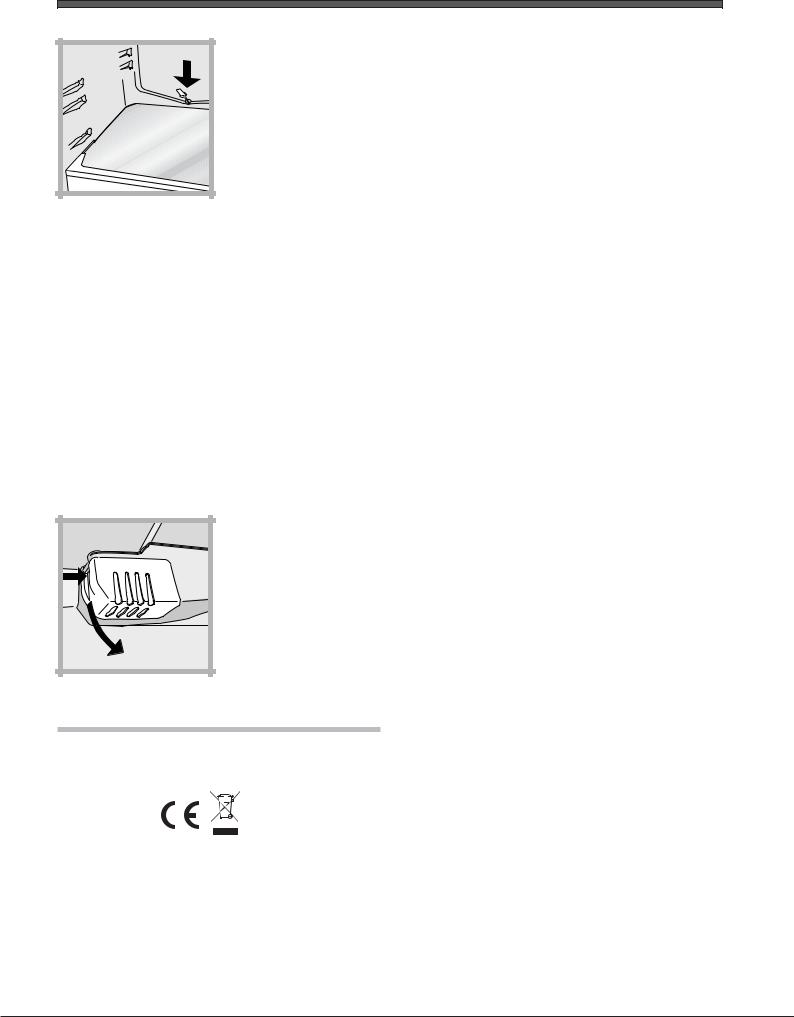
Defrosting the freezer compartment
If the frost layer is greater than 5 mm, it is necessary to defrost manually:
1.Set the TEMPERATURE ADJUSTMENT knob to the position .
.
2.Wrap frozen foods in newspaper and place them in another freezer or in a cool place.
3.Leave the door open until the frost has melted completely. This can be made easier by placing containers with lukewarm water in the freezer compartment.
4.Clean and dry the freezer compartment carefully before switching the appliance on again.
5.Wait for approximately 2 hours, i.e. until the ideal storage conditions have been restored, before placing food in the freezer compartment.
Replacing the light bulb
To replace the light bulb in the refrigerator compartment, pull out the plug from the electrical socket. Follow the instructions below. Access the light bulb by removing the cover as indicated in the diagram. Replace it with a similar light bulb within the power range indicated on the cover (15W or 25W).
1 |
2 |
Precautions and tips
! The appliance was designed and manufactured in compliance with international safety standards. The following warnings are provided for safety reasons and must be read carefully.
This appliance complies with the following Community Directives:
-73/23/EEC of 19/02/73 (Low Voltage) and subsequent amendments;
-89/336/EEC of 03.05.89 (Electromagnetic Compatibility) and subsequent amendments;
-2002/96/CE..
General safety |
|
|
GB |
||
• The appliance was designed for domestic use inside the home |
||
and is not intended for commercial or industrial use. |
|
|
|
•The appliance must be used to store and freeze food products by adults only and according to the instructions in this manual.
•The appliance must not be installed outdoors, even in covered areas. It is extremely dangerous to leave the appliance exposed to rain and storms.
•Do not touch the appliance with bare feet or with wet or moist hands and feet.
•Do not touch the internal cooling elements: this could cause skin abrasions or frost/freezer burns.
•When unplugging the appliance always pull the plug from the mains socket, do not pull on the cable.
•Before cleaning and maintenance, always switch off the appliance and disconnect it from the electrical supply. It is not
sufficient to set the temperature adjustment knobs on (appliance off) to eliminate all electrical contact.
(appliance off) to eliminate all electrical contact.
•In the case of a malfunction, under no circumstances should you attempt to repair the appliance yourself. Repairs carried out by inexperienced persons may cause injury or further malfunctioning of the appliance.
•Do not use any sharp or pointed utensils or electrical equipment - other than the type recommended by the manufacturer - inside the frozen food storage compartments.
•Do not put ice cubes taken directly from the freezer into your mouth.
•This appliance is not intended for use by persons (including children) with reduced physical, sensory or lack of experience and knowledge unless they have been given supervision or instruction concerning use of the appliance by a person responsible for their safety. Children should be supervised to ensure that they do not play with the appliance.
•Keep packaging material out of the reach of children! It can become a choking or suffocation hazard.
Disposal
•Observe local environmental standards when disposing packaging material for recycling purposes.
•The European Directive 2002/96/EC on Waste Electrical and Electronic Equipment (WEEE), requires that old household electrical appliances must not be disposed of in the normal unsorted municipal waste stream. Old appliances must be collected separately in order to optimise the recovery and recycling of the materials they contain and reduce the impact on human health and the environment. The crossed out “wheeled bin” symbol on the product reminds you of your obligation, that when you dispose of the appliance it must be separately collected. Consumers should contact their local authority or retailer for information concerning the correct disposal of their old appliance.
Respecting and conserving the environment
•Install the appliance in a fresh and well-ventilated room. Ensure that it is protected from direct sunlight and do not place it near heat sources.
•Try to avoid keeping the door open for long periods or opening the door too frequently in order to conserve energy.
•Do not fill the appliance with too much food: cold air must circulate freely for food to be preserved properly. If circulation is impeded, the compressor will work continuously.
•Do not place hot food directly into the refrigerator. The internal temperature will increase and force the compressor to work harder and will consume more energy.
•Defrost the appliance if ice forms (see Maintenance). A thick layer of ice makes cold transference to food products more difficult and results in increased energy consumption.
•Regularly check the door seals and wipe clean to ensure they are free of debris and to prevent cold air from escaping (see Maintenance).
9

GB Troubleshooting
If the appliance does not work, before calling for Assistance (see Assistance), check for a solution from the following list.
The internal light does not illuminate.
•The plug has not been inserted into the electrical socket, or not far enough to make contact, or there is no power in the house.
The refrigerator and the freezer do not cool well.
•The doors do not close properly or the seals are damaged.
•The doors are opened too frequently.
•The TEMPERATURE ADJUSTMENT knob is not in the correct position.
•The refrigerator or the freezer have been over-filled.
•The atmospheric temperature of the area surrounding the appliance is lower than 14°C.
The food inside the refrigerator is beginning to freeze.
•The TEMPERATURE ADJUSTMENT knob is not in the correct position.
•The food is in contact with the back inside wall of the refrigerator.
The motor runs continuously.
•The door is not closed properly or is continuously opened.
•The outside ambient temperature is very high.
•The thickness of the frost exceeds 2-3 mm (see Maintenance).
The appliance makes a lot of noise.
•The appliance has not been installed on a level surface (see Installation).
•The appliance has been installed between cabinets that vibrate and make noise.
•The internal refrigerant makes a slight noise even when the compressor is off. This is not a defect, it is normal.
Some of the external parts of the refrigerator become hot.
•These raised temperatures are necessary in order to avoid the formation of condensation on certain parts of the product.
The back wall of the refrigerator unit is covered in frost or
droplets of water
• This shows the appliance is operating normally.
There is water at the bottom of the refrigerator.
• The water discharge hole is blocked (see Maintenance).
10
